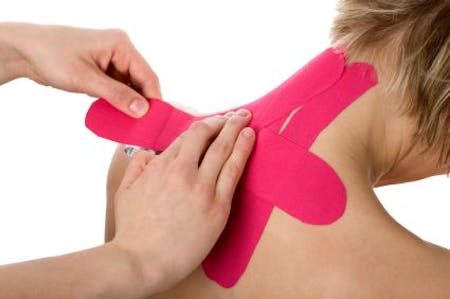
Kinesio® Tape is a latex-free, elastic porous cotton strip with an acrylic adhesive used for treating athletic injuries and a variety of other physical disorders. Kinesio® Tape stretches up to 140% of its original length, which allows much greater range of motion, compared to traditional white athletic tape. It can also be left on for longer periods of time (up to 4 days) before reapplication is needed.
Kinesio® Tape is about as thick as human epidermis (skin) and is designed to mimic its elastic properties to alleviate pain, reduce inflammation, relax muscles, enhance performance, and help with rehabilitation as well as supporting muscles during a sporting event.
The Kinesio Taping® (KT) Method is the rehabilitative application of Kinesio® Tape to facilitate the body's natural healing process while providing support and stability to muscles and joints without restricting the body's range of motion as well as providing extended soft tissue manipulation to prolong the benefits of manual therapy administered within the clinical setting.
Common Questions About Kinesio Taping®
The following are commonly asked questions about Kinesio® Tape and the Kinesio Taping® Method. Click the questions below for the answers.
How is the Kinesio® Tape applied?
Before the tape is applied, the Certified Kinesio Tape Practitioner assures that the patient's skin is clean and free of oils, sweat and lotions. Otherwise the tape will lose its adhesive abilities. After application, the practitioner rubs the tape to activate the heat sensitive glue. Approximately 30 to 60 minutes is required for the glue to become fully activated before the patient can become physically active or shower. If activity occurs prior to this time, the tape may come off.
Small amounts of body hair will not interfere with the effectiveness or adhesion of the tape. However, areas with significant amounts of hair should be clipped or shaved for best results and less pain when the tape is removed.
Correct tension is also key to success with Kinesio Taping®:
- For muscles that are injured or overused, needing relief and healing from pain and tightness, the tape is applied with no tension, starting from the tendons that hold the muscle to the bone and extending toward the origin of the muscle.
- For chronically injured or weakened muscles, needing support and full range of motion, the tape is applied with light tension, starting from the origin of the muscle and extending toward the tendons that hold the muscle to the bone.
Can I apply Kinesio® Tape myself?
It is important to apply the Kinesio strip with the correct degree of tension. If too much tension is applied, the effects are diminished. It is better not to have enough tension than too much. This is why it is important to have the Kinesio Tape applied by a Certified Kinesio Taping Practitioner, and only after a proper evaluation of your condition has been performed by qualified health professionals.
How do I maintain the Kinesio® Tape once it’s been applied?
During the first few days, if an edge of the tape has begun to lift, it can be trimmed. Rounding the edges may help prevent the edges from lifting prematurely. To dry tape after exercising, swimming or showering, pat gently with a towel. Do not use a hairdryer, because the adhesive is heat-activated and may become difficult to remove.
How does Kinesio® Taping differ from the traditional McConnell method of athletic taping?
Traditionally, athletes or others with muscle injuries would tape a muscle or joint to restrict motion and prevent further injury. Kinesiology taping takes the opposite approach, using the tape to open up the muscle and allow full movement.
How do I take the tape off?
Removing tape is best done by a Certified Kinesio Taping Practitioner (CKTP) to reduce the risk of re-injury or causing new injuries (as a result of incorrect removal). It is generally much easier to do when the patient has bathed or the tape is moist. The practitioner will remove the tape from the top down, in the direction of the body hair to limit any discomfort and skin irritation.
